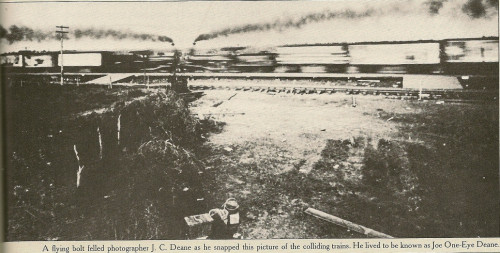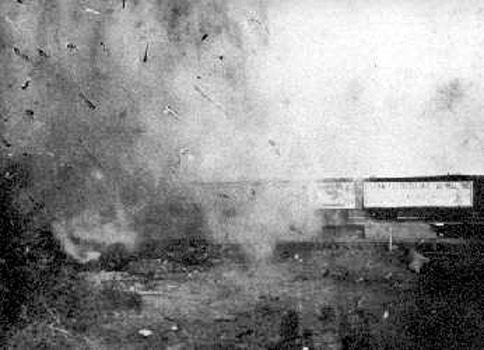The Great Train Crash at Crush, Texas, 1896Suppose you take two trains of equal mass, set them on a
The Great Train Crash at Crush, Texas, 1896Suppose you take two trains of equal mass, set them on a track facing each, and have them crash directly headlong at an equal speed. What would happen?In 1896 a Passenger Agent of the Missouri-Kansas-Texas rail line named William George Crush wanted to find out. The railroad company had a number of old outdated steam engines as surplus, and Crush proposed the experiment as part of a publicity stunt to help advertise the company.Two locomotives of the same model were repainted and restored, then set up on a track directly facing each other south of a town called West, Texas. The temporary town that was set up became known as Crush, named after the promoter of the event, William Crush. No admission was charged, and a result 40,000 people attended to see the spectacle, making Crush the second largest city in Texas at the time.At 5:00 PM the two trains, loaded with cars carrying railroad ties, were towed back 4 miles apart from each other. Once ready the engineers brought the locomotives up to a speed of 45 miles per hour then ditched before impact. It was predicted that at impact the two locomotives would fold into each other, almost like an accordion, then derail. While this may makes sense as two roughly equal forces collide, there was one factor that had not been taken into consideration.At the front of each locomotive was the steam engine, powered by a boiler which contained steam at high pressure. When the two trains collided the boilers exploded like bombs simultaneously. Shrapnel and debris showered the crowd causing people to flee in panic. The resulting shrapnel, from the size of a postage stamp to a driving wheel, killed three and injured dozens more. Even the event’s official photographer, Jarvis “Joe” Deane, lost an eye when struck by a flying bolt.After the explosion the two locomotives were reduced into an unrecognizable pile of wreckage, of which people gathered around to salvage souvenirs. The railroad company paid all claims against it without challenge. William Crush was fired that very evening, although he was rehired the next day. Apparently bad publicity is better than no publicity at all. -- source link
Tumblr Blog : peashooter85.tumblr.com
#history#trains#locomotive#explosion#experiment#publicity#publicity stunt#texas#crush#crush texas#william crush#locomotives#transportation#death#injury#accident#science

